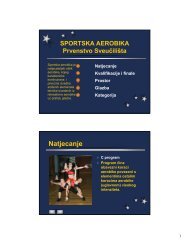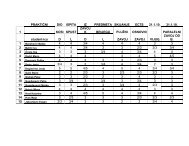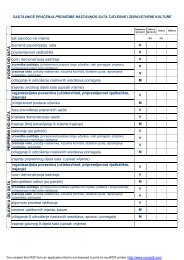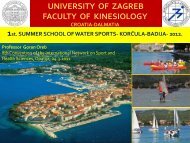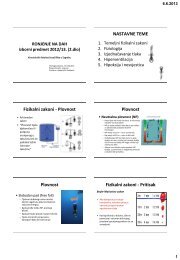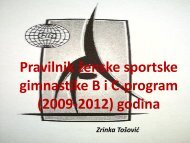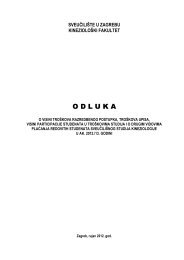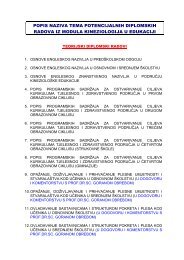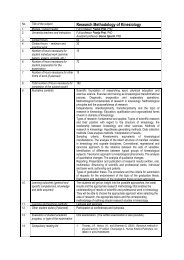The Journal of P hysiology Physiological adaptations to low-volume ...
The Journal of P hysiology Physiological adaptations to low-volume ...
The Journal of P hysiology Physiological adaptations to low-volume ...
You also want an ePaper? Increase the reach of your titles
YUMPU automatically turns print PDFs into web optimized ePapers that Google loves.
1078 M. J. Gibala and others J Physiol 590.5<br />
Table 1. Summary <strong>of</strong> pro<strong>to</strong>cols in studies from our labora<strong>to</strong>ry that directly compared 6 weeks <strong>of</strong> either high-intensity interval training<br />
(HIT) or traditional endurance training<br />
Variable HIT group Endurance group<br />
Pro<strong>to</strong>col 30 s × 4–6 repeats, 4.5 min rest (3 sessions per week) 40–60 min cycling (5 sessions per week)<br />
Training intensity (workload) ‘All out’ maximal effort (∼500 W) 65% <strong>of</strong> ˙V O2 peak (∼150 W)<br />
Weekly training time commitment ∼10 min (∼1.5 h including rest) ∼4.5 h<br />
Weekly training <strong>volume</strong> ∼225 kJ ∼2250 kJ<br />
From Burgomaster et al. (2008). ˙V O2 peak, peak oxygen uptake.<br />
training determined by a myriad <strong>of</strong> fac<strong>to</strong>rs including the<br />
precise nature <strong>of</strong> the exercise stimulus (i.e. the intensity,<br />
duration and number <strong>of</strong> intervals performed, as well<br />
as the duration and activity patterns during recovery).<br />
When compared on a matched-work basis or when<br />
estimated energy expenditure is equivalent, HIT can serve<br />
as an effective alternate <strong>to</strong> traditional endurance training,<br />
inducing similar or even superior changes in a range <strong>of</strong><br />
physiological, performance and health-related markers<br />
in both healthy individuals and diseased populations<br />
(Wisl<strong>of</strong>f et al. 2007; Tjonna et al. 2009; Hwang et al.<br />
2011). Less is known regarding the effects <strong>of</strong> <strong>low</strong>-<strong>volume</strong><br />
HIT, but growing evidence suggests this type <strong>of</strong> training<br />
stimulates physiological remodelling comparable with<br />
moderate-intensity continuous training despite a substantially<br />
<strong>low</strong>er time commitment and reduced <strong>to</strong>tal<br />
exercise <strong>volume</strong> (Gibala & McGee 2008). <strong>The</strong>se findings<br />
are important from a public health perspective, given<br />
that ‘lack <strong>of</strong> time’ remains one <strong>of</strong> the most commonly<br />
cited barriers <strong>to</strong> regular exercise participation (Stutts<br />
2002; Trost et al. 2002; Kimm et al. 2006). Moreover,<br />
recent evidence suggests that HIT is perceived <strong>to</strong> be more<br />
enjoyable than moderate-intensity continuous exercise<br />
(Bartlett et al. 2011). Here we review some <strong>of</strong> the<br />
mechanisms responsible for improved skeletal muscle<br />
metabolic control and changes in cardiovascular function<br />
in response <strong>to</strong> <strong>low</strong>-<strong>volume</strong> HIT, as well as the potential<br />
health-related implications for patients with chronic<br />
diseases including type 2 diabetes and cardiovascular<br />
disease. We also speculate on the practical application<br />
<strong>of</strong> <strong>low</strong>-<strong>volume</strong> HIT for elite performance. Although it is<br />
recognized that the underlying mechanisms are probably<br />
different compared with less-trained subjects (Iaia &<br />
Bangsbo 2010), responses in elite athletes may help our<br />
understanding <strong>of</strong> why <strong>low</strong>-<strong>volume</strong> HIT is such a potent<br />
exercise stimulus.<br />
<strong>Physiological</strong> remodelling after <strong>low</strong>-<strong>volume</strong> HIT<br />
<strong>The</strong> most common model employed in <strong>low</strong>-<strong>volume</strong> HIT<br />
studies has been the Wingate test, which consists <strong>of</strong> a 30 s<br />
‘all out’ cycling effort against a supra-maximal workload.<br />
Subjectstypicallyperformfour<strong>to</strong>sixworkboutsseparated<br />
by ∼4 min <strong>of</strong> recovery, for a <strong>to</strong>tal <strong>of</strong> 2–3 min <strong>of</strong> intense<br />
exercise during a training session that lasts ∼20 min. As<br />
little as six sessions <strong>of</strong> this type <strong>of</strong> training, <strong>to</strong>talling<br />
∼15 min <strong>of</strong> all out cycle exercise over 2 weeks, increased<br />
skeletal muscle oxidative capacity as reflected by the<br />
maximal activity and/or protein content <strong>of</strong> mi<strong>to</strong>chondrial<br />
enzymes (Burgomaster et al. 2005; Gibala et al. 2006).<br />
We have also directly compared 6 weeks <strong>of</strong> Wingate-based<br />
HIT with traditional endurance training that was designed<br />
according <strong>to</strong> current public health guidelines (Table 1)<br />
(Burgomaster et al. 2008; Rakobowchuk et al. 2008). We<br />
found similar training-induced improvements in various<br />
markers <strong>of</strong> skeletal muscle and cardiovascular adaptation<br />
despite large differences in weekly training <strong>volume</strong><br />
(∼90% <strong>low</strong>er in the HIT group) and time commitment<br />
(∼67% <strong>low</strong>er in the HIT group). In addition <strong>to</strong> an<br />
increased skeletal muscle oxidative capacity (Fig. 1), other<br />
endurance-like <strong>adaptations</strong> have been documented after<br />
several weeks <strong>of</strong> <strong>low</strong>-<strong>volume</strong> HIT including an increased<br />
resting glycogen content, a reduced rate <strong>of</strong> glycogen<br />
utilization and lactate production during matched-work<br />
exercise, an increased capacity for whole-body and skeletal<br />
muscle lipid oxidation, enhanced peripheral vascular<br />
structure and function, improved exercise performance<br />
as measured by time-<strong>to</strong>-exhaustion tests or time trials<br />
and increased maximal oxygen uptake (Burgomaster et<br />
al. 2005, 2008; Gibala et al. 2006; Rakobowchuk et al.<br />
2008).<br />
Wingate-based HIT is, however, extremely demanding<br />
and may not be safe, <strong>to</strong>lerable or appealing for some<br />
individuals. We therefore sought <strong>to</strong> design a more practical<br />
model <strong>of</strong> <strong>low</strong>-<strong>volume</strong> HIT that is time efficient while<br />
also having wider application <strong>to</strong> different populations<br />
including people at risk for chronic metabolic diseases. To<br />
accomplish this goal we decreased the absolute intensity <strong>of</strong><br />
the work bouts, but increased their duration and shortened<br />
the rest intervals. Our new practical HIT model consists<br />
<strong>of</strong> 10 × 60 s work bouts at a constant-load intensity that<br />
elicits ∼90% <strong>of</strong> maximal heart rate, interspersed with<br />
60 s <strong>of</strong> recovery. <strong>The</strong> pro<strong>to</strong>col is still time efficient in<br />
that only 10 min <strong>of</strong> exercise is performed over a 20 min<br />
training session. Importantly, this practical, time-efficient<br />
HIT model is still effective at inducing rapid skeletal<br />
muscle remodelling <strong>to</strong>wards a more oxidative phenotype,<br />
similar <strong>to</strong> our previous Wingate-based HIT studies and<br />
C○ 2012 <strong>The</strong> Authors. <strong>The</strong> <strong>Journal</strong> P<strong>hysiology</strong> C○ 2012 <strong>The</strong> <strong>Physiological</strong> Society<br />
Downloaded from J Physiol (jp.physoc.org) by guest on March 21, 2012


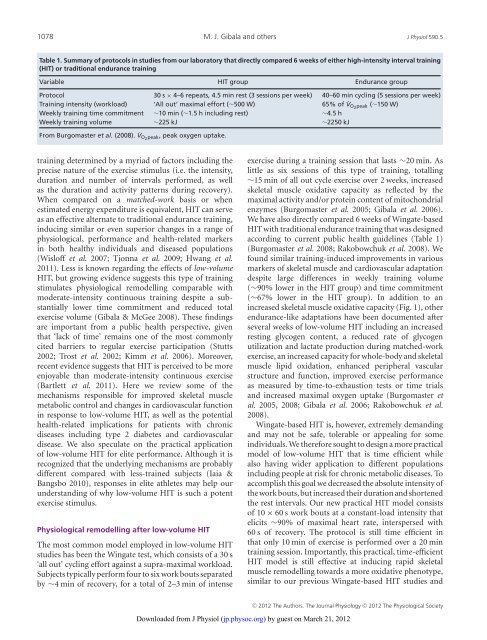

![NASTAVNI_PLAN_I_PROGRAM-_integrirani_studij [2,09 MiB]](https://img.yumpu.com/23830973/1/184x260/nastavni-plan-i-program-integrirani-studij-209-mib.jpg?quality=85)
